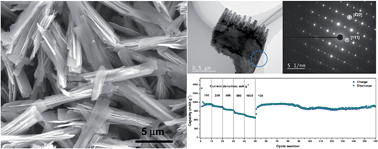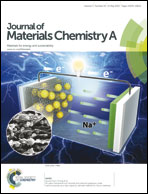Mesoporous quasi-single-crystalline NiCo2O4 superlattice nanoribbons with optimizable lithium storage properties†
Abstract
Mesoporous single-crystalline NiCo2O4 nanoribbons have been fabricated via a hexamethylenetetramine (HMT)-assisted hydrothermal method applied to Ni–Co precursor nanobelts, followed by annealing in an air atmosphere. The mesoporous single-crystalline feature was demonstrated by field-emission scanning electron microscopy, transmission electron microscopy, selected area electron diffraction, and N2 isotherm analyses. The specific surface area and pore size distribution aspects of the porous profile of the as-obtained spinel NiCo2O4 products could be tuned feasibly by changing the post-treatment temperature of the precursors, which, hence, allowed improvements to the electrochemical performance of the as-obtained products. As expected, when applied as an anode material in lithium-ion batteries, the mesoporous single-crystalline NiCo2O4 nanoribbons delivered a high specific capacity, excellent rate capability, and outstanding cycling performance. The reversible discharge capacity could reach 1198 mA h g−1 after 60 discharge–charge cycles at a current density of 200 mA g−1. The superior electrochemical performance can be attributed to the unique structure, including the suitable pore size distribution, mesoporous single-crystalline feature, enlarged specific surface area, and highly textured nanostructure, as well as synergetic effects of the different metal ions. This synthetic strategy could be extended to synthesize other mesoporous single-crystalline functional materials.


 Please wait while we load your content...
Please wait while we load your content...